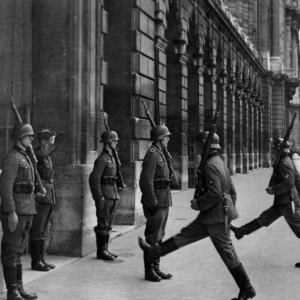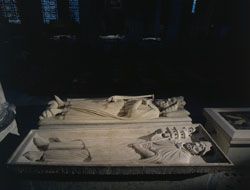 A funerary statue is a recumbent effigy of life-size statue sculptures dressed in their daily costume lying supine. It literally means “lying in repose” the words used for a deceased person exposed for final respects.
A funerary statue is a recumbent effigy of life-size statue sculptures dressed in their daily costume lying supine. It literally means “lying in repose” the words used for a deceased person exposed for final respects.
The light-filled royal necropolis of the basilica of Saint-Denis boasts over 70 funerary recumbent statues and tombs marking the final resting places of most of France’s historical figures. Out of the 16th recumbent effigies commissioned by Saint Louis, 14 funerary statues remain today to demonstrate that the bold adventurous Philippe III, Isabel d’Aragon, Philippe VI, the stubborn Louis X and the infant king Jean 1st were all heir to the Capetian dynasty.
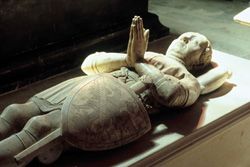 A faithful representation of the Valois dynasty effigies
A faithful representation of the Valois dynasty effigiesThe recumbent statues of the Valois Kings started with that of Charles V considered to be the first portrait in the history of funeral sculptures in France. Funerary representation of the deceased statues of Philippe VI de Valois, the wise Jean II, Charles V, Charles VI and Isabeau of Bavaria was very faithful to the way they looked when they were alive.
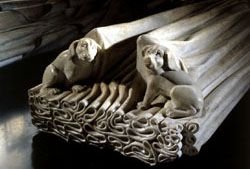 The Cathedral Basilica is one of the first masterpieces of Gothic art. St Denis became the necropolis of several kings and queens of France. The Basilica became a major pilgrimage destination as it linked its destiny to that of the royal recumbent statues and tombs of the French monarchy. Visit the sculptures of most of the monarch’s princes and kings and some of the major servants of the realm from Clovis, Childebert, Fredegunda, Charles d’Anjou, the Duke of Orléans.
The Cathedral Basilica is one of the first masterpieces of Gothic art. St Denis became the necropolis of several kings and queens of France. The Basilica became a major pilgrimage destination as it linked its destiny to that of the royal recumbent statues and tombs of the French monarchy. Visit the sculptures of most of the monarch’s princes and kings and some of the major servants of the realm from Clovis, Childebert, Fredegunda, Charles d’Anjou, the Duke of Orléans.
The evolution of French architecture and sculpture through the centuries is reflected through most of the exposed recumbent tombs of the XIIIth century.
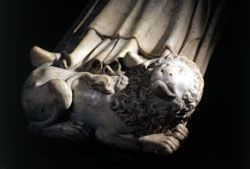 Many funerary statues from the bold adventurous Philippe III, Philippe IV, Isabel d’Aragon who is Philippe’s III daughter in law exposed in the naïve and choir are considered to be in hieratic position. Legend has it that all the recumbent tombs of the kings buried in the church in the thirteenth century mark the various trends in funeral art through a realistic image of their lives. Dogs representing fidelity are exposed at the foot of women on their tombs. Nevertheless here it may be taken as a representation of guide dogs in the underground realms of death. Lions are carved at the foot of men’s recumbent tombs representing bravery, strength, ferocity and valour.
Many funerary statues from the bold adventurous Philippe III, Philippe IV, Isabel d’Aragon who is Philippe’s III daughter in law exposed in the naïve and choir are considered to be in hieratic position. Legend has it that all the recumbent tombs of the kings buried in the church in the thirteenth century mark the various trends in funeral art through a realistic image of their lives. Dogs representing fidelity are exposed at the foot of women on their tombs. Nevertheless here it may be taken as a representation of guide dogs in the underground realms of death. Lions are carved at the foot of men’s recumbent tombs representing bravery, strength, ferocity and valour.
In the Middles Ages, three models of recumbent statues were generally made : entrails, heart and body. The king was thus honored by three tombs. This multiplication of burial sepultures resulted in the difficulty of preserving the body during transport.
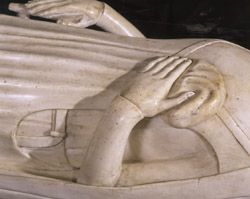
After death, the belly of the deceased was opened to remove the entrails. Followed by the ablation of the heart. You can easily identify a recumbent figure’s heart by the presence of a small heart carved on the left hand side of the statue and the entrails can be identified by the presence of a small bag in the hand of the character.
In Saint-Denis the more noble recumbent statues were found, that of the body. Body preservation techniques were rudimentary in the Middle Ages. During transport, the body was covered with salt, spices and wine which played the role of antiseptic. The most surprising aspect was the custom used at that time, in particular by Saint Louis, which was to boil the body in order to separate the flesh from the bone. When the sovereign figure died of dysentery in Carthage, the flesh of the holy king was buried in the Cathedral of Monreale, in Sicile and the bones were transported to Saint Denis. From the pass of the Chapel located in the north of Paris to the royal abbey, Philippe III the Bold carried the ashes of his father on his shoulders; a route that has since been marked by a series of seven pilgrimages identified by crosses and royal sculptures, les Montjoies.
